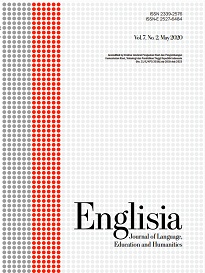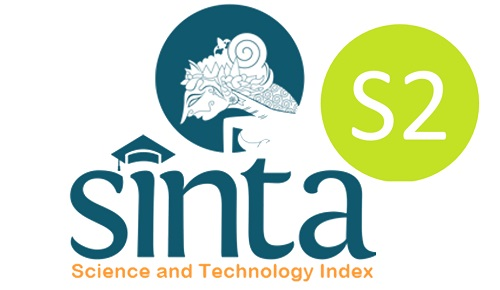The semiotic and modern hermeneutic review of the online Covid-19 public service advertisement texts
DOI:
https://doi.org/10.22373/ej.v10i2.15005Keywords:
public service advertisements, Covid-19, semiotics, modern hermeneuticsAbstract
The Indonesian government works closely with other agencies to intensely campaign for the movement against the virus corona in various ways, one of which is through Public Service Advertisements (PSAs). PSAs have verbal and non-verbal elements that contain meanings, both explicit and implicit meanings. This article aims to analyze three samples of PSAs concerning Covid-19 retrieved from three online website media, namely (1) the website of the Ministry of Education, Culture, Research and Technology of the Republic of Indonesia; (2) Republika online; and (3) Kompas.com. This research was conducted using qualitative descriptive methods referring to the semiotic theory developed by Roland Barthes and Charles Sanders Peirce, and the modern hermeneutics theory developed by Paul Ricoeur. The analysis of the PSAs in this study was focused on verbal texts, while non-verbal texts were not analyzed deeply. From the three PSAs analyzed, the study found that the explicit meanings lying in the PSAs were to fight the coronavirus by complying with health protocols. Meanwhile, implicitly, the PSAs imply that the Indonesian people are under threat of death, the coronavirus is not a lie, nor is it a conspiracy.
Downloads
References
Djamereng, A. (2018). Analisi Semiotika pada Iklan di Televisi (Iklan Wardah dan Iklan Total Almeera). Jurnal Al-Khitabah, 4(1), 1–17. Retrieved from http://journal.uin-alauddin.ac.id/index.php/Al-Khitabah/article/view/4713
Hoed, B. H. (2014). Semiotik dan Dinamika Sosial Budaya (3rd ed.). Depok: Komunitas Bambu.
Kridalaksana, H. (2011). Kamus Linguistik (4 (3)). Jakarta: PT Ikrar Mandiriabadi.
Mahsun. (2006). Metode Penelitian Bahasa: Tahapan Strategi, Metode, dan Tekniknya (2nd ed.). Jakarta: PT Rajagrafindo Persada.
Nuraryo, I. (2020). Analisis Semiotika Roland Barthes Iklan Ayo Jaga Keluarga dan Bangsa Indonesia dengan Mencegah Penularan Covid-19.
Nuryadin, T. R. W. (2020). Kalimat Imperatif dalam Iklan Layanan Masyarakat Berbahasa Arab Terkait Covid-19, 3(4), 385–392. Retrieved from http://diglosiaunmul.com/index.php/diglosia/article/view/87
Putri, I. G. A. V. W. (2020). Semiotika Tanda Verbal Dan Visual Pada Iklan Kampanye Pencegahan Penyebaran Covid-19. KULTURISTIK: Jurnal Bahasa Dan Budaya, 4(2), 10–18. Retrieved from https://doi.org/10.22225/kulturistik.4.2.1871
Ricoeur, P. (2005). Filsafat Wacana (3rd ed.). Yogyakarta: IRCiSoD.
Sulatra, I. K., & Eka Pratiwi, D. P. (2020). The Ideology within Covid-19 Public Service Advertisements: A Semiotic Approach. Humanis, 24(4), 350. Retrieved from https://doi.org/10.24843/jh.2020.v24.i04.p02
Thalib, A. A. (2018). Filsafat Hermeneutika dan Semiotika. Palu: LPP-Mitra Edukasi.
Thomson, J. B. (2005). Filsafat Bahasa dan Hermeneutik (1st ed.). Surabaya: Penerbit Visi Humanika.
Tinarbuko, S. (2017). Semiotika Tanda Verbal dan Tanda Visual Iklan Layanan Masyarakat. Panggung, 26(2), 181–194. Retrieved from https://doi.org/10.26742/panggung.v26i2.175
Trisnayanti Ni Made Desi, Desak Putu Eka Pratiwi, & Komang Dian Puspita Candra. (2021). Discovering Hidden Messages in Covid-19 Advertisement “Stay Home Save Lives”: A Semiotic Analysis. RETORIKA: Jurnal Ilmu Bahasa, 7(1), 25–31. Retrieved from https://doi.org/10.22225/jr.7.1.3137.25-31
van Lier, L. (2004). The Ecology and Semiotics of Language Learning: A Sociocultural Perspective. New York, Boston, Dordrecht, London, Moscow: Kluwer Academic Publishers.
Downloads
Published
Issue
Section
License
Proposed Policy for Journals That Offer Open Access
Authors who publish with Englisia journal agree to the following terms:
- Authors retain copyright and grant the journal right of first publication with the work simultaneously licensed under a Creative Commons Attribution License that allows others to share the work with an acknowledgement of the work's authorship and initial publication in this journal.
- Authors are able to enter into separate, additional contractual arrangements for the non-exclusive distribution of the journal's published version of the work (e.g., post it to an institutional repository or publish it in a book), with an acknowledgement of its initial publication in this journal.
- Authors are permitted and encouraged to post their work online (e.g., in institutional repositories or on their website) prior to and during the submission process, as it can lead to productive exchanges, as well as earlier and greater citation of published work (See The Effect of Open Access).









